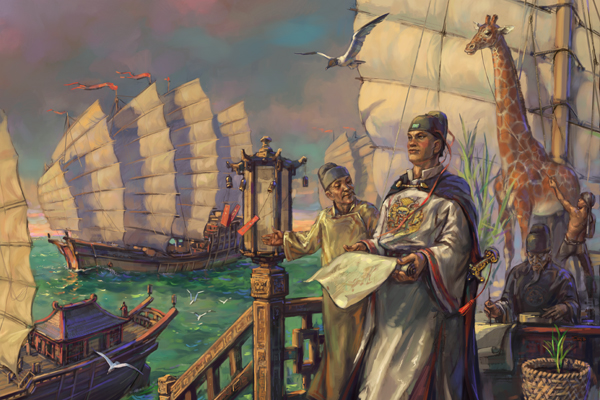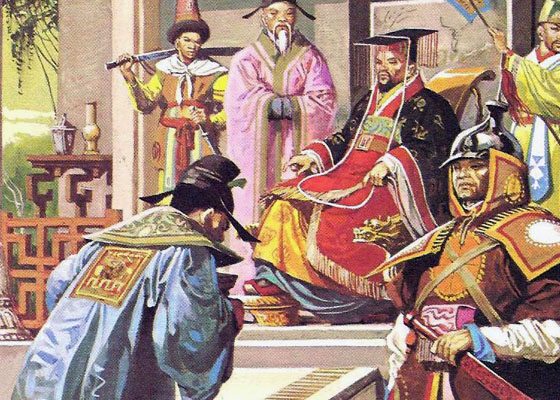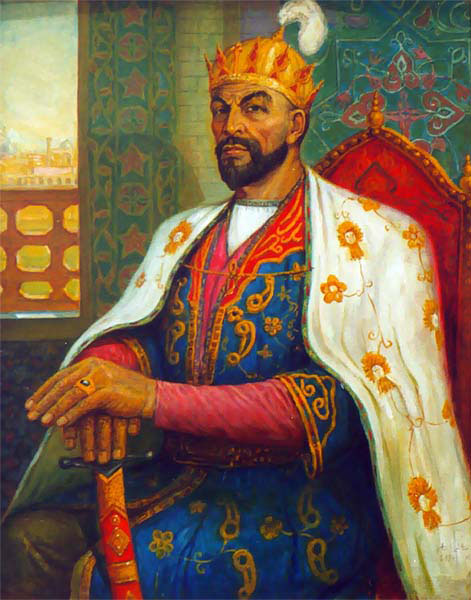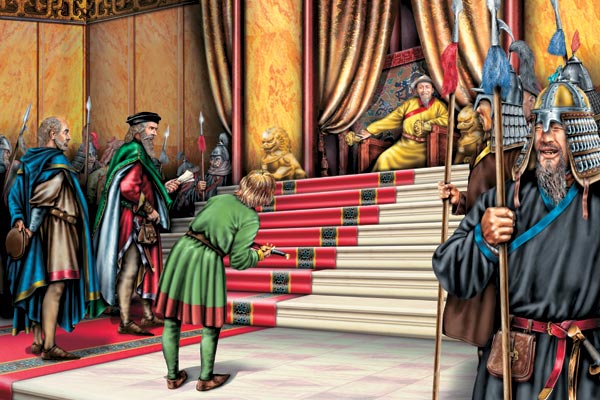
Graduate student of the Institute of History and Ethnology named after Ch. Valikhanov N.B. Aysaeva prepared interesting material on the history of China's foreign policy relations with Central Asian states. The editors of the Portal consider it necessary to support interesting works of young scientists and publish some excerpts from this work.
The Ming epoch is known in the history of China as the time of the closest political-diplomatic and trade-economic relations with the Central Asian states. How did the Chinese monarch build a foreign policy strategy?

Zheng He at the head of the marine expeditions of the Chinese squadron
In order to establish diplomatic and trade relations, the emperor sent his embassies to foreign countries. One of the foreign policy steps of the imperial court was the organization of marine expeditions of Chinese Columbus - Zheng He. During his seven expeditions in 1405-1433 the Chinese ships visited the islands of the Sunda archipelago, the coasts of Southeast Asia, India, Arabia, East Africa and mastered important sea routes long before Christopher Columbus.
It should be noted that caravan trade also contributed to the establishment of relations between China and other states, which subsequently assumed the character of embassy missions.

The Chinese dynasty Ming ruled for about 300 years (1368-1644).
The Danish trade was the foundation of foreign policy in the early period of the Ming dynasty, with the addition of two new functions. This was the principle of impartiality among vassal states and the principle of complexity.
In Western literature, there are terms such as "tributary relations" and "tributary system" - a mechanism through which the barbarian, i.e. non-Chinese, the countries took their place in the Chinese world order. In turn, in Soviet literature, there is the term "system of nominal vassalage of foreign countries". Such "vassalage" was purely nominal and was not a form of political dependence.

The hegemony of China over the countries of Central Asia aroused dissatisfaction among many rulers. So, for example, Amir Timur had a complicated relationship because of non-payment of "tribute".
Under the rule of the emperor Yongle, the Ming dynasty sent a large number of embassies to various parts of Asia. The embassies visited Tibet, Nepal, Beshbalyk and Samarkand. In the work "Chinese documents and materials on the history of East Turkestan, Central Asia and Kazakhstan in XIV - XIX centuries" was written:
"In 1395, the King ordered Gei Shizhong, Fu An and others to deliver a message with the imperial seal, as well as banknotes and cloths in gratitude. The horses, sent by Samarkand, exceeded the number of 1000 annually. At the same time they were given banknotes of baochao for payment of these horses. With the enthroned Chengtsu traditionally sent an embassy with his letter to notify Timur about this. In 1405 the court learned that Timur through Beshbalyk led the army to the east. It was ordered to take precautions. Amir Timur was preparing for war with China, but arriving in Otrar in January, he fell ill and died on February 18, which led to the cancellation of the campaign against China. After Timur's death, the Sino-Central Asian relations again normalized."
With regard to the campaign begun by Amir Timur to China in late 1404, there were also reasons for it. The fact is that the Chinese Emperor Zhu Yuan-Chang (1368-1398) from the Ming dynasty, which replaced the Mongol Yuan dynasty and subsequent emperors, considered themselves legitimate heirs of the Great Ulus, which included Mongolia and China. Accordingly, they applied for the remaining three Ulus, including Chagatai, then under the rule of Amir Timur. In diplomatic correspondence, the Chinese emperor called Amir Timur "son". In the language of diplomacy, this meant "subordinate" which greatly offended the pride of the Lame conqueror.

Amir Timur
Diplomatic relations between China and the Timurid state stabilized under the reign of Amir Timur's fourth son Shakhrukh since 1409, with the arrival of ambassadors from China to Herat, who expressed condolences on the death of Timur. This embassy headed Fu An.
"In 1407, Fu An and others finally returned to their homeland. From the very beginning, upon arrival in Samarkand, they were detained there. Timur ordered An to be driven across many possessions in order to boast of the vastness of his state. When Timur passed away, his grandson Khali, or Khalil, succeeded to his throne, so he sent his ambassador Hudayd and others to accompany Fu An and handed over the products of local production for offering. In addition, he sent Bayarsitay and others for the rite of commemoration 31 for their deceased ruler Timur, as well as the handing over of the new ruler and his possession of silver coins. One of the tribal chiefs named Shalinurdin, also gave camels and horses to China. It was ordered to give patterned silks to their ruler, and go to Samarkand along with his tributary embassy."
In the work of M. Rossabi "Ming China and Turfan, 1406-1517" the normalization of relations between China and the states of Asia is also mentioned. The study provides data on the frequency and nature of embassies, tributary missions during the reign of Emperor Yongle.

In 1412, an embassy arrived from China to Herat, which was taken with unusual solemnity (in honor of the arrival of ambassadors their homes were decorated with silk fabrics and carpets). Travel of ambassadors from China to the West continued later. In his letters the Chinese emperor tried to reconcile Shakhrukh and Khalil Sultan, who after Timur's death began to share his legacy.
In the work “From the History of International Relations and Diplomacy of Central Asia in the second half of the 15th and early 16th centuries” of M. Karimov based on the work of Hafizi Abru, the reception ceremony for these ambassadors is described.
"The city is put in order, the best goods of merchants and artisans are exhibited in the markets, arms and other military equipment are hung on the main roads. Ambassadors are received by noble courtiers with all the honors. Shakhrukh himself receives ambassadors in the garden "Zagon" and arranges a feast in their honor. After that, the ambassadors pass the letter of the Chinese emperor Doi Ming to Shakhrukh. In his letter, the Chinese emperor expresses his pleasure with the state of cooperation and offers to constantly exchange ambassadors. The letter was compiled in two copies, each in Persian, Turkic and Chinese languages. Shakhrukh signed the second copy, which was with the ambassadors. After this, each courtier separately arranged a large feast in honor of the ambassadors. After the completion of these ceremonies, Shakhrukh sends an embassy headed by Sheikh Muhammad Bakhshi as his representative to the Chinese emperor with a return letter, with which the Chinese embassy is also returning."
All external relations were regulated by rituals - the exchange of envoys, ambassadors, the exchange of gifts, the reception of diplomatic missions and even extradition. Thus, it was during the Ming Dynasty that most diplomatic missions and travelers went outside the country. During the reign of the Ming Dynasty, about 30 countries were included in the vassal system of the empire under different conditions. Such a significant expansion of the borders fit into the philosophical basis of the foreign policy of the dynasty - China stands in the center of the civilized world, and the emperor possesses the Mandate of Heaven.
As N.B. Aysaeva, China's domestic and foreign policy was based on the main doctrine - Sino-centrism: the foreign policy doctrine had full control over all aspects, including foreign trade and travel by sea. In addition, foreign trade relations were conducted only with states that recognized the supremacy of the Chinese empire and only when tribunal missions came.
By Arman SULEIMENOV
Translated by Raushan MAKHMETZHANOVA
Use of materials for publication, commercial use, or distribution requires written or oral permission from the Board of Editors or the author. Hyperlink to National Digital History portal is necessary. All rights reserved by the Law RK “On author’s rights and related rights”. To request authorization email to kaz.ehistory@gmail.com or call to (7172) 79 82 06 (ext.111).
